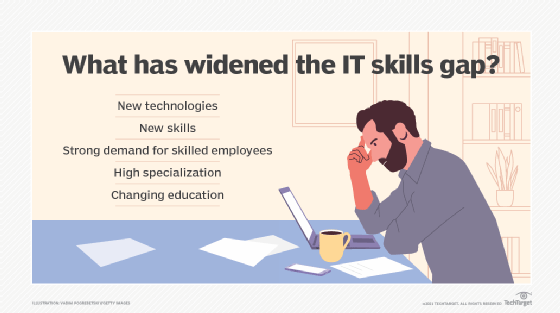
Getty Images/iStockphoto
12 IT skills development strategies to close gaps in IT ops
Strategic approaches to IT operations skills gaps include assessment programs, training, mentorship and automation -- essential elements for organizational agility and innovation.
A skills gap happens when there's a mismatch between employer expectations for technical skills and what skills employees actually possess. Continuous learning presents a particular challenge in the IT industry, where rapid technological advancements create a constant feeling of playing catch-up to maintain proficiency.
Skills gaps affect an organization's immediate capabilities and services, reducing agility and creating inefficiencies. They also hinder long-term growth and innovation, which could negatively affect a company's ability to grow or even survive.
Although skills gaps abound in other parts of the IT industry, this article identifies strategies for addressing concerns within traditional on-premises IT operations teams. IT leaders can apply some or all of these techniques to identify, develop and retain skills.
Establish and support training opportunities
Start with training opportunities to address skills gaps. Numerous modern approaches to technical training make this option even more effective than in the past. Virtualized lab environments, custom training options, AI-based assessments and remote training opportunities enable selective and effective learning.
1. Introduce a skills assessment program to identify specific skills gaps
It's essential to know the IT ops team's current skill set before defining improvement plans. Begin with a skills assessment program that identifies both existing capabilities and development opportunities.
Various methods exist for evaluating skills, including these approaches:
- Self-assessment.
- Credentials review.
- Practical exams and simulations.
- Interviews.
Plan to use a combination of these methods for the best results. Review the findings and discuss with teams and individuals.
2. Set clear training objectives
Next, define clear training objectives based on the skills assessment results. Targeting specific skills gap concerns lets organizations make the most of their training budgets. Consider creating two or more layers of goals, including these objectives:
- Department or team-level training objectives to ensure a specific team can fulfill its role.
- Individual training objectives tailored to the skills and goals of each staff member and tied to annual reviews and career development plans.
3. Integrate internal training academies
One effective skills development option is an internal learning resource. These training academies provide structured programs to upskill IT staff to meet the organization's operational requirements and long-term goals.
Internal training academies are flexible, evolve with the organization's needs and can integrate with daily operations. Internal experts or external trainers can provide instruction.
4. Offer diverse training opportunities and methods
Implement diverse training programs that cater to specific learning modalities and then help employees select the training method that works best for their learning style. Many IT professionals rely on tactile, hands-on training.
Examples of this type of training include the following:
- Workshops and seminars.
- Conferences.
- Online, synchronous instructor-led training.
- Asynchronous training.
- Industry certifications.
- Formalized on-the-job training.
Don't forget to partner with vendors for product-specific training. Vendors sometimes include training resources as part of product licensing.
Organizations should provide adequate funding and time for these methods of skill development.
5. Use modern learning tools
The technical training industry has evolved as quickly as other aspects of IT. From internet-accessible synchronous courses to cloud-based virtualized lab environments, training is more flexible, practical and hands-on than ever before. Ensure that all selected training modalities use modern training methods for the most effective knowledge transfer.
6. Continuously evaluate progress
Be sure to evaluate your team's progress to keep the program on track. Periodic assessments, such as the initial skills assessment, are critical for identifying growth and meeting key performance indicators. Review training goals and achievements regularly. Annual reviews might not be frequent enough, so consider quarterly discussions.

Establish learning in the workplace
The following strategies emphasize day-to-day learning techniques within a job role. This approach offers immediate application of knowledge, a tailored learning experience and cost-effective skills development. It also provides a continuous learning experience that follows new deployments in the environment.
Consider pairing on-the-job training with cross-functional collaboration to build knowledge and redundancy across teams. Implement these practices by rotating assignments among team members.
7. Develop documentation and knowledge-sharing resources
Documentation and internal wikis often improve problem-solving responses and reduce errors. They support other initiatives, such as onboarding, on-the-job training and collaboration. These resources enable continuous improvement and learning by enabling personnel to research and resolve problems based on past issues.
Although the use of documentation is essential, developing reference material also fosters knowledge sharing. Verifying and updating knowledge base documents and procedures can be a great way for newer IT ops team members to become familiar with practices.
8. Create mentored onboarding processes
One effective method for developing skills and preparing new employees for their role is mentored onboarding. Pairing a new employee with a more seasoned IT ops team member allows for personalized guidance and explanations of business-specific processes using a flexible approach.
In addition to transferring knowledge, such a pairing also fosters cultural integration and team building. Mentorship also works well for newly promoted or transferred IT staff who might have experience with other parts of the company. For example, consider pairing an employee transferring from the help desk to the IT operations team with a more experienced administrator.
Create a culture that embraces and empowers learning
The following tips will help you establish a culture that encourages and empowers learning. Empower employees to explore new technologies and develop their own career plans based on their interests. The formalized mentoring initiatives discussed above can also be supplemented by informal pairing within the team.
9. Promote continuous learning
In this culture, learning should be an integral part of daily operations. Managers and team members should be committed to skills development and knowledge sharing. Leadership must provide access to learning resources, including the various methods outlined above. Career progression should be tied to demonstrable skills, mentorship should be available and cross-functional collaboration opportunities must exist.
10. Establish a skills-based career progression framework
Define a structured system for employee advancement based on skill development using specific competencies to track growth. Tie this growth to the employee's career progression and opportunities. When the supervisor and employee create the development plan together, it ensures the employee is moving in a direction they wish to go while also satisfying employer requirements. After setting expectations, the employee can participate in the learning activities defined above to enhance their skills.
11. Support a collaborative culture across departments
Foster a culture of collaboration that reaches beyond an employee's own team to other diverse business units. In many ways, this idea is the seed for DevOps, which combines development practices with operations functions. Collaboration establishes learning as a core value by exposing employees to new practices, technologies and priorities.
12. Use automation to make learning resources available
Time is one of IT's most valuable resources. It's also one of the most common excuses inhibiting training and career development. Automation is an effective way to increase efficiency and free time for staff members. Explore ways to automate manual and time-consuming tasks to enable administrators to take advantage of learning opportunities.
Consider automating the following tasks:
- Patch management for servers, workstations and network devices.
- VM provisioning, templates and self-service options for development or other teams.
- Automatic ticket creation based on issues such as low disk space, service failures or offline systems.
Automation also enhances both consistency and efficiency.
Conclusion
Employee skills gaps affect an organization's agility, efficiency and resource use. They can also significantly affect daily IT operations and related services. Creating a culture that encourages learning and offering diverse skills development opportunities helps prevent technological stagnation, which threatens any organization. Use these practices to keep your company competitive and at its best.
Damon Garn owns Cogspinner Coaction and provides freelance IT writing and editing services. He has written multiple CompTIA study guides, including the Linux+, Cloud Essentials+ and Server+ guides, and contributes extensively to TechTarget Editorial, The New Stack and CompTIA Blogs.








